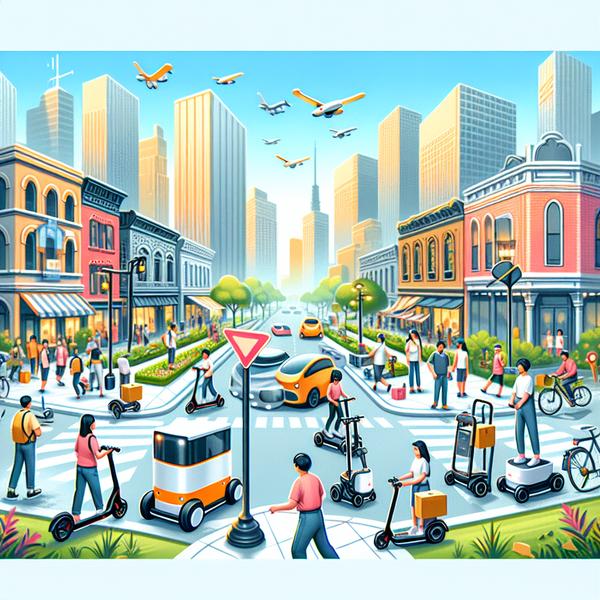
As cities grow busier, micromobility solutions like e-scooters, delivery robots, and motorized wheelchairs are revolutionizing how we approach short-distance travel in urban areas. But a significant challenge remains: most of these solutions still rely on human control, limiting their efficiency and raising safety concerns. Researchers from UCLA and the University of Washington have developed an innovative solution called URBAN-SIM, a simulation platform that trains robots to operate independently in city environments. Its companion framework, URBAN-BENCH, sets the standard for evaluating real-world skills. Together, they aim to push autonomous micromobility forward while ensuring safer and more sustainable cities.
Urban Micromobility: Bridging the Last-Mile Gap
- Urban micromobility has emerged as the unsung hero for tackling "last-mile connectivity," which standard transport like cars and buses struggle to address.
- These lightweight devices, such as electric scooters, excel in urban areas by providing low-speed, eco-friendly transport solutions. Yet, without autonomy, their usability remains limited.
- Consider needing to cross a busy city street with barriers – a fully autonomous scooter could easily map the route while avoiding hazards like pedestrians and cyclists.
- Today’s micromobility needs expanded AI capabilities to overcome tight sidewalks, uneven surfaces, and many unpredictable obstacles present in cities.
- With rapid urbanization, focusing on solving these challenges is crucial for creating smarter and more sustainable cities.
The Unique Challenges of Simulating Complex Urban Environments
- Unlike highways or indoor spaces, urban areas present ever-changing dynamics: think of shifting pedestrian crowds, wandering pets, or delivery trucks parking in bike lanes.
- Traditional robot learning platforms are too simplified, focusing on smooth terrains or minimal interactions. This doesn’t prepare AI systems for open-air urban areas filled with staircases or cobblestones.
- For example, basic simulations might train a robot to avoid obstacles. However, dealing with a biker swerving onto a walking path—a real-life urban scenario—needs more advanced simulation tools.
- URBAN-SIM creates high-fidelity environments, from narrow alleys filled with trash bins to wide public plazas with roaming crowds, ensuring AI gets realistic training.
- This complexity necessitates real-time adaptability equipped with scalable solutions to process demanding data volumes.
How URBAN-SIM Creates Smarter AI
- URBAN-SIM’s standout tool is its Hierarchical Urban Scene Generation—a feature capable of crafting millions of layouts pairing sidewalks with complex city elements like ramps and stairs.
- The system integrates NVIDIA's Omniverse and PhysX physics engine to provide hyper-realistic visuals. This ensures robots train in spaces mimicking reality.
- Imagine a challenge where delivery robots must climb spiral indoor stairs before entering streets filled with crowds. URBAN-SIM prepares them by simulating nuanced physics for such scenarios.
- Interactive Agent Simulation is another highlight. AI systems learn through scenarios with human-like pedestrians, bikers, and even buses stopping abruptly.
- AI agents not only learn survival—they refine how efficiently and safely they navigate busy urban chaos by incorporating this real-world trial preparation.
The Benchmark for Autonomous Mobility: URBAN-BENCH
- URBAN-BENCH complements URBAN-SIM with a purpose-built benchmark suite, ensuring what robots learn aligns with real-world expectations.
- For example, Urban Locomotion tasks test stability when machines move across uneven, outdoor terrains like wet bricks or sudden road cracks.
- Think of a wheelchair navigating winding city parks during peak hours while avoiding joggers or dogs. Urban Navigation tasks focus on mastering this type of adaptability.
- The Urban Traverse task takes complexity even further: robots face kilometer-long, obstacle-filled courses that demand sharp decision-making and long-term planning skills.
- This system balances human-AI collaboration, letting humans intervene at critical points while letting AI carry most responsibilities during routine operations.
Training Diverse Robotics for All Scenarios
- Not every robot is made equal, and URBAN-SIM showcases this by testing wheeled robots, quadrupeds, wheeled-leg hybrids, and humanoid robots in varying urban setups.
- For instance, wheeled robots outperform others on wide, flat streets, while humanoid designs are champions in swiftly navigating crowded paths by sidestepping and adjusting to space constraints.
- Quadrupeds excel on tricky terrains like gravels or stairs due to their inherent stability. On the other hand, hybrid robots offer the flexibility of switching between terrains seamlessly.
- An asynchronous training model boosts efficiency where AI methodologies achieve up to 26.3% improvements compared to traditional systems thanks to varied scene exposures.
- Rich diversity in simulations translates into more robust AI, ready to manage real-world situations spanning quiet suburbs to bustling commercial centers.